Postpartum period
A postpartum (or postnatal) period begins immediately after the birth of a child as the mother's body, including hormone levels and uterus size, returns to a non-pregnant state.[1] The terms puerperium or puerperal period, or immediate postpartum period are commonly used to refer to the first six weeks following childbirth.[2] The World Health Organization (WHO) describes the postnatal period as the most critical and yet the most neglected phase in the lives of mothers and babies; most maternal and newborn deaths occur during the postnatal period.[3] In scientific literature, the term is commonly abbreviated to Px, where x is a number; for example, "day P5" should be read as "the fifth day after birth". This is not to be confused with the medical nomenclature that uses G P to stand for number and outcomes of pregnancy (gravidity and parity).
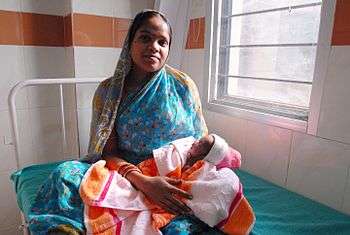
A woman giving birth in a hospital may leave as soon as she is medically stable, which can be as early as a few hours postpartum, though the average for a vaginal birth is one to two days. The average caesarean section postnatal stay is three to four days.[4] During this time, the mother is monitored for bleeding, bowel and bladder function, and baby care. The infant's health is also monitored.[5] Early postnatal hospital discharge is typically defined as discharge of the mother and newborn from the hospital within 48 hours of birth.
The postpartum period can be divided into three distinct stages; the initial or acute phase, 6–12 hours after childbirth; subacute postpartum period, which lasts 2–6 weeks, and the delayed postpartum period, which can last up to six months.[2] In the subacute postpartum period, 87% to 94% of women report at least one health problem.[6][7] Long-term health problems (persisting after the delayed postpartum period) are reported by 31% of women.[8]
Acute phase
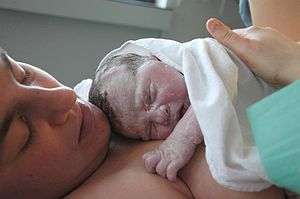
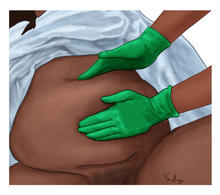
The first 6 to 12 hours after childbirth is the initial or acute phase of the postpartum period.[2] During this time the mother is typically monitored by nurses or midwives as complications can arise in this period.
The greatest health risk in the acute phase is postpartum bleeding. Following delivery the area where the placenta was attached to the uterine wall bleeds, and the uterus must contract to prevent blood loss. After contraction takes place the fundus (top) of the uterus can be palpated as a firm mass at the level of the navel. It is important that the uterus remains firm and the nurse or midwife will make frequent assessments of both the fundus and the amount of bleeding. Uterine massage is commonly used to help the uterus contract.[9]
Following delivery if the mother had an episiotomy or tearing at the opening of the vagina, it is stitched. At one time an episiotomy was routine, however more recent research shows that a surgical incision may be more extensive than a natural tear, and is more likely to contribute to later incontinence and pain during sex than a natural tear would have. A healthcare professional can recommend comfort measures to help to ease perineal pain[9]
Infant caring in the acute phase
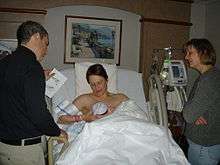
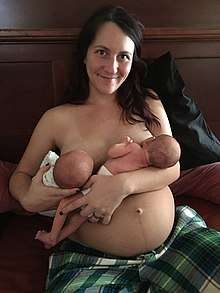
Within about 10 seconds the infant takes its first breath and the caregiver places the baby on the mother's chest. The infant's condition is evaluated using the Apgar scale. The Apgar score is determined by evaluating the newborn baby on five criteria which are summarized using words chosen to form a backronym (Appearance, Pulse, Grimace, Activity, Respiration). Until recently babies were routinely removed from their mothers following birth, however beginning around 2000, some authorities began to suggest that early skin-to-skin contact (placing the naked baby on the mother's chest) is of benefit to both mother and infant. As of 2014, early skin-to-skin contact, also called kangaroo care, is endorsed by all major organizations that are responsible for the well-being of infants. Thus, to help establish bonding and successful breastfeeding, the caregiver carries out immediate mother and infant assessments as the infant lies on the mother's chest and removes the infant for further observations only after they have had their first breastfeed. The World Health Organization (WHO) also encourages skin-to-skin contact for the first 24 hours after birth to help regulate the baby's temperature.[10]
Subacute postpartum period
The subacute postpartum starts after the acute postpartum period concludes and can last for 2–6 weeks.[2]
Physical recovery in the subacute postpartum period
In the first few days following childbirth, the risk of DVT is relatively high as hypercoagulability increases during pregnancy and is maximal in the postpartum period,[11] particularly for women with C-section with reduced mobility. Anti-coagulants may be prescribed or physical methods such as compression are commonly indicated to decrease the risk of DVT.
The increased vascularity and edema of the woman's vagina gradually resolves in about three weeks. The cervix gradually narrows and lengths over a few weeks.[12] Postpartum infections can lead to sepsis and if untreated, death.[13] Postpartum urinary incontinence is experienced by about 33% of all women; women who deliver vaginally are about twice as likely to have urinary incontinence as women who give birth via a cesarean.[14] Urinary incontinence in this period increases the risk of long term incontinence.[2]
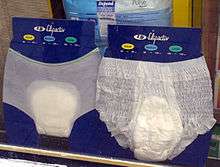
Discharge from the uterus, called lochia, will gradually decrease and turn from bright red, to brownish, to yellow and cease at around five or six weeks. Women are advised in this period to wear adult diapers or nappies, disposable maternity briefs, maternity pads or towels, or sanitary napkins. The use of tampons or menstrual cups are contraindicated as they may introduce bacteria and increase the risk of infection.[15] An increase in lochia between 7–14 days postpartum may indicate delayed postpartum hemorrhage.[1]
Hemorrhoids and constipation in this period are common, and stool softeners are routinely given.[16]
In the subacute postpartum period, 87% to 94% of women report at least one health problem.[6][7]
Infant caring in the subacute period
At 2–4 days postpartum, a woman's milk will generally come in.[17] Historically, women who were not breastfeeding were given drugs to suppress lactation, but this is no longer medically indicated. In this period, difficulties with breastfeeding may arise. Maternal sleep is often disturbed as night waking is normal in the newborn, and newborns need to be fed every two hours, including during the night.[18] The lactation consultant and health visitor may be of assistance at this time.
Psychological disorders
During the subacute postpartum period, psychological disorders may emerge. Among these are postpartum depression, posttraumatic stress disorder, and in rare cases, puerperal psychosis.[19] Postpartum mental illness can affect both mothers and fathers, and is not uncommon.[20] Early detection and adequate treatment is required. Approximately 25–85% of postpartum women will experience the "blues" for a few days. Between 7% and 17% may experience clinical depression, with a higher risk among those women with a history of clinical depression. Prevalence of PTSD following normal childbirth (excluding stillbirth or major complications) is estimated to be between 2.8% and 5.6% at six weeks postpartum.[21]
Delayed postpartum period
The delayed postpartum period starts after the subacute postpartum period and lasts up to six months.[2] During this time, muscles and connective tissue returns to a pre-pregnancy state. Recovery from childbirth complications in this period, such as urinary and fecal incontinence, painful intercourse, and pelvic prolapse, are typically very slow and in some cases may not resolve.[2] Symptoms of PTSD often subside in this period, dropping from 2.8% and 5.6% at six weeks postpartum to 1.5% at six months postpartum.[21][22]
Approximately three months after giving birth (typically between two and five months), estrogen levels drop and large amounts of hair loss is common, particularly in the temple area (postpartum alopecia). Hair typically grows back normally and treatment is not indicated.[23][24] Other conditions that may arise in this period include postpartum thyroiditis.
During this period, infant sleep during the night gradually increases and maternal sleep generally improves.[18]
Long-term health problems (persisting after the delayed postpartum period) are reported by 31% of women.[8]
Cultures
_A_Birth_Scene_(Desco_da_Parte)%2C_c._1410_Harvard_Art_museum_(2).jpg)
Postpartum confinement refers to a system for recovery following childbirth. It begins immediately after the birth, and lasts for a culturally variable length: typically for one month or 30 days,[25] up to 40 days, two months or 100 days.[26] This postnatal recuperation can include "traditional health beliefs, taboos, rituals, and proscriptions."[27] The practice used to be known as "lying-in", which, as the term suggests, centres around bed rest. (Maternity hospitals used to use this phrase, as in the General Lying-in Hospital.) Postpartum confinement customs are well-documented in China, where it is known as "Sitting the month", and similar customs manifest all over the world. A modern version of this rest period has evolved, to give maximum support to the new mother, especially if she is recovering from a difficult labour and delivery.
In other cultures like in South Korea, a great level of importance is placed on postnatal care. Sanhujori is the term for traditional postnatal care in Korea and is a practice followed by the majority of women for the purpose of proper recovery after giving birth.[28] Deeply rooted in Korean culture, sanhujori has similarly evolved with today's society from being heavily reliant on the mothers’ family members to include services that encompass its principles, which is apparent with the over 500 sanhujori centers in operation around Korea.[29]
See also
References
- Kansky C (July 2016). "Normal and Abnormal Puerperium: Overview, Routine Postpartum Care, Hemorrhage". Medscape. Cite journal requires
|journal=(help) - Romano M, Cacciatore A, Giordano R, La Rosa B (April 2010). "Postpartum period: three distinct but continuous phases". Journal of Prenatal Medicine. 4 (2): 22–5. PMC 3279173. PMID 22439056.
- WHO. "WHO recommendations on postnatal care of the mother and newborn". WHO. Retrieved 22 December 2014.
- "Recovering from a caesarean section". NHS Choices. Retrieved 16 December 2016.
- Vernon D (2007). With Women, Midwives Experiences: from Shiftwork to Continuity of Care. Canberra: Australian College of Midwives. p. 17. ISBN 978-0-9751674-5-8.
- Glazener CM, Abdalla M, Stroud P, Naji S, Templeton A, Russell IT (April 1995). "Postnatal maternal morbidity: extent, causes, prevention and treatment". British Journal of Obstetrics and Gynaecology. 102 (4): 282–7. doi:10.1111/j.1471-0528.1995.tb09132.x. PMID 7612509.
- Thompson JF, Roberts CL, Currie M, Ellwood DA (June 2002). "Prevalence and persistence of health problems after childbirth: associations with parity and method of birth". Birth (Berkeley, Calif.). 29 (2): 83–94. doi:10.1046/j.1523-536X.2002.00167.x. PMID 12051189.
- Borders N (2006). "After the afterbirth: a critical review of postpartum health relative to method of delivery". Journal of Midwifery & Women's Health. 51 (4): 242–248. doi:10.1016/j.jmwh.2005.10.014. PMID 16814217.
- Mayo Clinic staff (30 July 2015). "Labor and delivery, postpartum care". Mayo Clinic. Retrieved 15 August 2015.
- Phillips R. "Uninterrupted Skin-to-Skin Contact Immediately After Birth". Medscape. Retrieved 21 December 2014.
- Fiengo L, Bucci F, Patrizi G, Giannotti D, Redler A (February 2013). "Postpartum deep vein thrombosis and pulmonary embolism in twin pregnancy: undertaking of clinical symptoms leading to massive complications". Thrombosis Journal. 11 (1): 4. doi:10.1186/1477-9560-11-4. PMC 3629711. PMID 23433174.
- "Childbirth recovery and postpartum care". www.aboutkidshealth.ca. Retrieved 2018-04-22.
- WHO (2013). "WHO recommendations on postnatal care of the mother and newborn". World Health Organization. Archived from the original on 22 December 2014. Retrieved 22 December 2014.
- Thom DH, Rortveit G (December 2010). "Prevalence of postpartum urinary incontinence: a systematic review". Acta Obstetricia et Gynecologica Scandinavica. 89 (12): 1511–22. doi:10.3109/00016349.2010.526188. PMID 21050146.
- N. H. S. Choices (2017-07-20). "How soon can I use tampons after giving birth?". N.H.S. Choices. Retrieved 2018-04-22.
- "Postpartum hemorrhoids". Baby Center. Retrieved 2018-05-19.
- "Breastfeeding: the first few days". www.nhs.uk. 2017-12-21. Retrieved 2018-04-22.
- McGuire E (July 2013). "Maternal and infant sleep postpartum". Breastfeeding Review. 21 (2): 38–41. PMID 23957180.
- Dobson V, Sales B (2000). "The Science of Infanticide and Mental Illness". Psychology, Public Policy, and Law. 6 (4): 1098–1112. doi:10.1037/1076-8971.6.4.1098.
- "Postpartum Depression". Canadian Mental Health Association. Retrieved July 9, 2014.
- Olde E, van der Hart O, Kleber R, van Son M (January 2006). "Posttraumatic stress following childbirth: a review". Clinical Psychology Review. 26 (1): 1–16. doi:10.1016/j.cpr.2005.07.002. hdl:1874/16760. PMID 16176853.
- Alder J, Stadlmayr W, Tschudin S, Bitzer J (June 2006). "Post-traumatic symptoms after childbirth: what should we offer?". Journal of Psychosomatic Obstetrics and Gynaecology. 27 (2): 107–12. doi:10.1080/01674820600714632. PMID 16808085.
- SCHIFF, BENCEL L. (1963-05-01). "Study of Postpartum Alopecia". Archives of Dermatology. 87 (5): 609–11. doi:10.1001/archderm.1963.01590170067011. ISSN 0003-987X. PMID 13991677.
- Eastham, John H (February 2001). "Postpartum Alopecia". The Annals of Pharmacotherapy. 35: 255–258. doi:10.1345/1542-6270(2001)035<0255:pa>2.0.co;2. ISSN 1060-0280.
- Chien YC, Huang YJ, Hsu CS, Chao JC, Liu JF (March 2009). "Maternal lactation characteristics after consumption of an alcoholic soup during the postpartum 'doing-the-month' ritual". Public Health Nutrition. 12 (3): 382–8. doi:10.1017/S1368980008002152. PMID 18426631.
- "Confinement practices: an overview". BabyCenter. Retrieved 2016-03-21.
- Tung W (22 June 2010). "Doing the Month and Asian Cultures: Implications for Health Care". Home Health Care Management & Practice. 22 (5): 369–371. CiteSeerX 10.1.1.1020.5139. doi:10.1177/1084822310367473.
- Yoo, Eun Kwang; Jung, Eun Sil (2016). "Outlook of sanhujori from Korean women residing in the US" (PDF). Advanced Science and Technology Letters. 128: 203–207.
- Yoo, Eun Kwang; Kim, Hye Jin (2016). "Unmarried Single Women's Awareness of Sanhujori" (PDF). Advanced Science and Technology Letters. 128: 183–187.
External links
- eMedicine: Normal and Abnormal Puerperium
- Patient UK: Postnatal Care (Puerperium)
- NHS Choices Birth to Five Planner: Postnatal post-traumatic stress disorder
- Postpartum care of mother and newborn: WHO